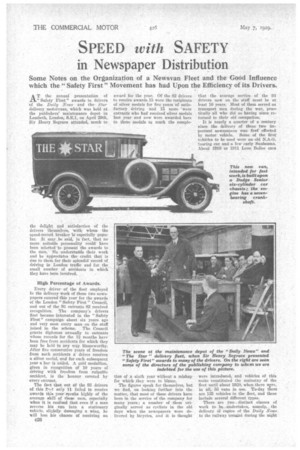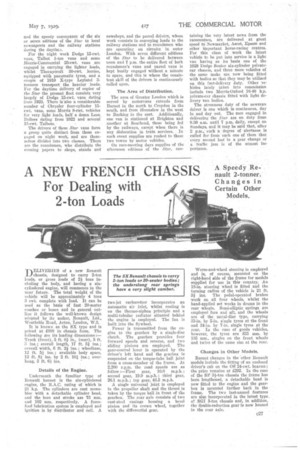SPEED with SAFETY
Page 58

Page 59

If you've noticed an error in this article please click here to report it so we can fix it.
in Newspaper Distribution
Some Notes on the Organization of a Newsvan Fleet and the Good Influence which the "Safety First" Movement has had Upon the Efficiency of its Drivers.
AT the annual presentation of " Safety First" awards to drivers of the Daily News and the Sear delivery motorvans, which was held at the publishers' maintenance depot in Lambeth, London, S.E.I, on April 29th, Sir Fleury Segrave attended, much to the delight and satisfaction of the drivers themselves, with whomthe speed-record .breaker IS' especially popular. it may, be said, in fact, that no more. Suitable personality. could..have been '.seleeted•to.Present the -aWards to the then. lie underStands their work and he "apPreciates the' creditthat is due to theta for their splendid record of driving in London traffic and for the small number of accidents in which they have been involved.
High Percentage of Awards.
Every driver of the fleet employed in the delivery work of these two newspapers entered this year for the awards
• of the London "Safety First "' Council, and out of the 93 entrants 82 received recognition. The company's drivers first became interested in the " Safety First" campaign about six years ago and very WWI every man on the staff joined in. the seheme. The, Council grants diplomas annually to entrants whose records for the 12 months have been free from accidents for which they may be held in any way blameworthy. After five consecutive years of freedom from such accidents a driver receives a sili-er medal, and for each subsequent year a bar is added. A gold medallion, given in recognition of 10 years of driving with freedom from culpable accident, is the honour coveted by every en Iran t.
The fact that out of the 93 drivers of this only 11 foiled to receive awards this year Ppeaks highly of the average skill of these men, especially when it is realized that even if a man reverse: his van into a stationary vehicle, slightly damaging a wing, he will lose bis chance of receiving an
026 award for the year. Of the 82 drivers to receive awards 15 were the recipients of silver medals for five years of satisfactory driving and 15 more were entrants who had received silver medals last year and now were awarded bars to these medals to mark the comple
tion of a sixth year without a mishap for which they were to blame.
The figures speak for themselves, but we find, on looking further into the matter, that most of these. drivers have been in the service of the company for many years ; a number of them originally served as cyclists in the old days when the newspapers were delivered by bicycles, and it is thought
that the average service of the 93 drivers now on the staff must be at least 10 years. Most of them served as transport men during the war, practically all who did so having since returned, to their old occupation.
It is nearly a quarter of a century since the delivery of these two important newspapers was first' effected: ixs motor vehicle. Some of the first vehicles to be used were an old N.A.G. louring car and a few early Sunbeams. About 1910 or 1911 Leon Dollee cars
were introduced, and vehicles of this make constituted the mainstay'. of the fleet until about 120, when there were, in all; 56 vans in use. Today there Eire 135 vehicles in the fleet, and these include several different types.
There are two •. distinct classes of work to be,Ondertakim, . namely, tlie• . delivery Of . copies. of the Daily -News to the railway termini during the night •
and the speedy conveyance of the six or seven editions of the Star to local newsagents and the railway stations during the daytiras.
For the night work Dodge 15-cwt. vans, Talbot 1-ton vans and some Morris-Commercial 25-cwt. vans .are engaged in carrying the lighter loads, whilst Thornycroft 30-cwt, lorries, equipped with pneumatic tyres, and a couple of 1910 X-type Leyland 3tonners transport the heavier loads. For the daytime delivery of copies of the Star the present fleet consists very largely of Dodge 15-cwt. vans dating from 1923. There is also a considerable number of Chrysler four-cylinder 15cwt. vans some Morris 8-cwt. vehicles for very light loads, half a dozen Leon. Bollees dating from 1922 and several 15-cwt. Talbots.
The drivers of these Star vans form a group quite distinct from those engaged on night work, and are themselves divided into two classes. There are the roundsmen, who distribute the evening papers to shops, stands and newsboys, and the parcel drivers, whose work consists in conveying loads to the railway stations and to roundsmen who are operating oii circuits in outer London. With seven different editions of the Star to be delivered between noon and 7 p.m. the entire fleet of both roundsmen's vans and parcel vans is kept busily engaged without a minute to spare, and this is where the consistent skill of the drivers is continuously called upon.
The Area of Distribution.
The area of Greater London which is served by motorvans extends from Barnet in the north to Croydon in the south, and from Hounslow in the west to Barking in the east. Additionally, one van is stationed at Brighton and another at Southend, these being fed by the railways, except when there is any dislocation in train services. In such event supplies are rushed to these two towns by motor vehicles.
On race-meeting days supplies of the afternoon editions of the Star, con
the very latest news from the ses, are delivered at great speed tc Newmarket, Ascot, Epsom and other itnportant horse-racing centres. For this class of work the latest vehicle to be put into service is a light van having as its basis one of the 1929 Dodge Senior six-cylinder privatecar chassis, and three more vehicles of the same make are now being fitted with bodies so that they may be utilized on this fast-delivery duty. Other vehicles lately taken into commission include two Morris-Oxford 16-40
private-car chassis fitted with light delivery van bodies.
The strenuous duty of the newsvan driver is one which is continuous, day in and day out. The men engaged in delivering the Star are on duty from 9.30 a.m. until 7 p.m. daily, except on Sundays, and it may be said that, after 2 p.m., such adegree of alertness is called for from each one of them that every second lose in a gear change or a traffic jam is of the utmost importance.
tabling racecou






























































































































